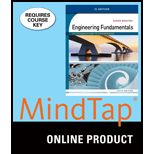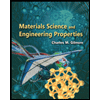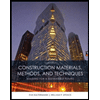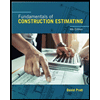
MindTap Engineering, 2 terms (12 months) Printed Access Card for Moaveni's Engineering Fundamentals, SI Edition, 5th
5th Edition
ISBN: 9781305110250
Author: MOAVENI, Saeed
Publisher: Cengage Learning
expand_more
expand_more
format_list_bulleted
Concept explainers
Question
Chapter 3, Problem 5P
To determine
Investigate the design of bottle caps, provide the important design parameters, and discuss the advantages and disadvantages associated with each design.
Expert Solution & Answer
Trending nowThis is a popular solution!

Students have asked these similar questions
A4.1- For a concentrically loaded tied short column, with the cross-section shown in Figure 1,
a) Find the axial load resistance of the column;
b) Check if the spacing between the longitudinal bars is satisfying code requirements;
c) Determine the required spacing between the ties, and sketch the tie arrangement
as per the code.
Given: f'c = 25 MPa
fy = 400 MPa
T
550 mm
550 mm
Maximum aggregate size: 20mm
Longitudinal bars: 8-25M
Figure 1
Ties: 10M (ties are not shown on cross-section. The arrangement to be determined in part c)
Clear cover to the ties: 40mm
When using a work breakdown structure (WBS) for a project why it is necessary to break down activities?
As shown in the figure below, a 1.5 m × 1.5 m footing is
carrying a 400 kN load.
P
Depth (m)
0.0
1.0
2.0
Df
Groundwater
table
(Yw = 9.81 kN/m³)
3.5
Yt = 16.5 kN/m³
E = 9,000 kPa
Sandy
soil
Ysat 17.5 kN/m³
E = 15,000 kPa
6.0
Stiff Clay
(OCR = 2)
Bedrock
Ysat 18.0 kN/m³
eo = 0.8
Cc = 0.15, Cr = 0.02
Eu =40,000 kPa
(a) Estimate the immediate settlement beneath the center of the
footing. Assuming that Poisson's ratios of sand and soft clay are
0.3 and 0.5, respectively. Use numerical integration approach.
For the calculations, use layers (below the bottom of the footing)
of thicknesses: 1 m; 1.5 m, and 2.5 m.
(b) Determine the primary consolidation settlement beneath the
center of the footing.
(c) Redo Part (b) if OCR=1.1.
Note: Use the 2:1 method to determine the stress increase below
the footing. For parts (b) and (c), use the one-dimensional
consolidation theory.
Chapter 3 Solutions
MindTap Engineering, 2 terms (12 months) Printed Access Card for Moaveni's Engineering Fundamentals, SI Edition, 5th
Ch. 3.2 - Prob. 1BYGCh. 3.2 - Describe the process by which engineers evaluate...Ch. 3.2 - Prob. 3BYGCh. 3.2 - Why do economics and material selection play...Ch. 3.2 - Prob. 5BYGCh. 3.2 - Prob. BYGVCh. 3.4 - Prob. 1BYGCh. 3.4 - Prob. 2BYGCh. 3.4 - Prob. 3BYGCh. 3.4 - Prob. BYGV
Ch. 3.6 - Prob. 1BYGCh. 3.6 - Prob. 2BYGCh. 3.6 - Prob. 3BYGCh. 3.6 - Prob. 4BYGCh. 3.6 - Prob. 5BYGCh. 3.6 - Prob. BYGVCh. 3 - Prob. 1PCh. 3 - Prob. 2PCh. 3 - Prob. 3PCh. 3 - Prob. 4PCh. 3 - Prob. 5PCh. 3 - Prob. 6PCh. 3 - Prob. 7PCh. 3 - Discuss in detail at least two methods or...Ch. 3 - Prob. 10PCh. 3 - Identify and make a list of at least ten products...Ch. 3 - Prob. 14PCh. 3 - Prob. 15PCh. 3 - Prob. 16PCh. 3 - Prob. 17PCh. 3 - Collect information on the American Wire Gage...Ch. 3 - Prob. 19PCh. 3 - Prob. 20PCh. 3 - Prob. 21PCh. 3 - Prob. 22PCh. 3 - Prob. 23PCh. 3 - Prob. 24PCh. 3 - Prob. 25PCh. 3 - Prob. 27PCh. 3 - Prob. 28PCh. 3 - Prob. 30PCh. 3 - Prob. 31PCh. 3 - Prob. 32PCh. 3 - Prob. 33PCh. 3 - Prob. 34PCh. 3 - Prob. 35PCh. 3 - Prob. 36PCh. 3 - Prob. 37PCh. 3 - Prob. 38PCh. 3 - Prob. 39PCh. 3 - Prob. 40P
Knowledge Booster
Learn more about
Need a deep-dive on the concept behind this application? Look no further. Learn more about this topic, civil-engineering and related others by exploring similar questions and additional content below.Similar questions
- Consider the cross-sections illustrated in the next slides. Implement a cross-sectional analysis based on a layered discretisation of the cross- section as required at the following. 1) Develop the implementation of an analysis to estimate the nonlinear response of the composite steel-concrete section, of the reinforced concrete section and of the steel section shown in following slides (using material nonlinear models provided in the support files). Provide the details of the numerical implementation with clear explanations of all steps. Hint: the implementation can be done in Excel. 2) Discuss how the 3 cross-sections (shown in the next slides) compare to each other in terms of embodied carbon under the condition that the cross-sections possess the same nominal moment capacity (i.e. the peak moment achieved in the moment-curvature diagram). The discussion should include at least 2 sets of the sections (each set contains one composite section, one reinforced concrete section and one…arrow_forwardConsider the following static route choice problem where 110 vehicles travel from point A to point B. The corresponding travel time (in minutes) of each link is as follows: t₁ = x1; t₂ = x2 + 20; t3x3 + 10; t₁ = 3×4 where Xi denotes the number of vehicles that choose link i. Find the number of vehicles that travel on each link when a. The user equilibrium condition (UE) is satisfied, where vehicles select the route with the minimum travel time; and b. The system optimum condition (SO) is satisfied, where the total travel time is minimised. C. Report the total delay savings when satisfying SO instead of UE. 2 B A 3 4arrow_forward= α₂+ Assume an origin is connected to a destination with two routes. Assume the travel time of each route has a linear relationship with the traffic flow on the route (t₁ = α₁ + b₁x₁ ; t₂ b2x2). Determine under what condition (e.g. a relationship among the parameters of the performance functions) tolling cannot reduce the total travel time of the two routes.arrow_forward
- Beban berjalan pada konstruksi balok seperti pada gambar, tentukan besar gaya dalam yang terjadi dengan metode Garis Pengaruh. Gaya dalam berupa : Reaksi tumpuan RA dan RB, Gaya lintang max di titik C, Momen Maksimum di titik C A + Dimana: B D 10 5 m 5 m P1 = 12t P2 = 6t P3 = 18t q= 6 t/m 2 3 q = 6 t/m P1 P2 P3arrow_forwardConsider the following static route choice problem where 110 vehicles travel from point A to point B. The corresponding travel time (in minutes) of each link is as follows: t₁ = x1 ; t₂ = = x2 + 20; t3 = x3 + 10; t₁ = 3x4 where Xi denotes the number of vehicles that choose link i. Find the number of vehicles that travel on each link when a. The user equilibrium condition (UE) is satisfied, where vehicles select the route with the minimum travel time; and b. The system optimum condition (SO) is satisfied, where the total travel time is minimised. C. Report the total delay savings when satisfying SO instead of UE. 2 A B 3 4arrow_forward= Assume an origin is connected to a destination with two routes. Assume the travel time of each route has a linear relationship with the traffic flow on the route (t₁ = α₁ + b₁×₁ ; t₂ b2x2). Determine under what condition (e.g. a relationship among the parameters of the performance functions) tolling cannot reduce the total travel time of the two routes. a2+arrow_forward
- For the soil system presented below, calculate and draw diagrams of distributions of the totaland effective stresses and pore water pressure. Assume an upward water flow with a velocity of0.000,001 cm/s.arrow_forwardRefer to attached problem.arrow_forwardCalculate: a) effective stresses at points A and B before the placement of foundations 1 and 2, b)the increase of pressure at point A as a result of the placement of the circular foundation 1, c) theincrease of pressure at point B as a result of the placement of the strip foundation 2.arrow_forward
- Consider the total head-loss in the system forthis flow is 18.56 ft (head-losses in first and second pipe are 13.83 ft and 4.73 ftrespectively). Please show numerical values for EGL/HGL at the beginning/end/intermediatechange point. (Point distribution: elevation determination 5 points, EGL, HGL lines 4points)arrow_forwardAs shown in the figure below, a 1.5 m × 1.5 m footing is carrying a 400 kN load. P Depth (m) 0.0 1.0 2.0 Df Groundwater table (Yw = 9.81 kN/m³) 3.5 Yt = 16.5 kN/m³ E = 9,000 kPa Sandy soil Ysat 17.5 kN/m³ E = 15,000 kPa 6.0 Stiff Clay (OCR = 2) Bedrock Ysat 18.0 kN/m³ eo = 0.8 Cc = 0.15, Cr = 0.02 Eu =40,000 kPa (a) Estimate the immediate settlement beneath the center of the footing. Assuming that Poisson's ratios of sand and soft clay are 0.3 and 0.5, respectively. Use numerical integration approach. For the calculations, use layers (below the bottom of the footing) of thicknesses: 1 m; 1.5 m, and 2.5 m. (b) Determine the primary consolidation settlement beneath the center of the footing. (c) Redo Part (b) if OCR=1.1. Note: Use the 2:1 method to determine the stress increase below the footing. For parts (b) and (c), use the one-dimensional consolidation theory.arrow_forwardAssuming that the whole DMV is only handled by one queue and one server and both the arrival rate (20 customer per hour) and the service rate (30 customers per hour) random variables are Markovian. (a) What is the mean queue length? [3 pts] (b) Percentage of Idle time of the server? [3 pts] (c) Average number in the queue? [3 pts] (d) Average number in the system? [3 pts] (e) The average wait time in the queue? [3 pts] (f) The average wait time in the system? [3 pts] (g) The probability that no one is in the system. [2 pts]arrow_forward
arrow_back_ios
SEE MORE QUESTIONS
arrow_forward_ios
Recommended textbooks for you
 Engineering Fundamentals: An Introduction to Engi...Civil EngineeringISBN:9781305084766Author:Saeed MoaveniPublisher:Cengage Learning
Engineering Fundamentals: An Introduction to Engi...Civil EngineeringISBN:9781305084766Author:Saeed MoaveniPublisher:Cengage Learning Materials Science And Engineering PropertiesCivil EngineeringISBN:9781111988609Author:Charles GilmorePublisher:Cengage Learning
Materials Science And Engineering PropertiesCivil EngineeringISBN:9781111988609Author:Charles GilmorePublisher:Cengage Learning Construction Materials, Methods and Techniques (M...Civil EngineeringISBN:9781305086272Author:William P. Spence, Eva KultermannPublisher:Cengage Learning
Construction Materials, Methods and Techniques (M...Civil EngineeringISBN:9781305086272Author:William P. Spence, Eva KultermannPublisher:Cengage Learning Fundamentals Of Construction EstimatingCivil EngineeringISBN:9781337399395Author:Pratt, David J.Publisher:Cengage,
Fundamentals Of Construction EstimatingCivil EngineeringISBN:9781337399395Author:Pratt, David J.Publisher:Cengage,

Engineering Fundamentals: An Introduction to Engi...
Civil Engineering
ISBN:9781305084766
Author:Saeed Moaveni
Publisher:Cengage Learning

Materials Science And Engineering Properties
Civil Engineering
ISBN:9781111988609
Author:Charles Gilmore
Publisher:Cengage Learning

Construction Materials, Methods and Techniques (M...
Civil Engineering
ISBN:9781305086272
Author:William P. Spence, Eva Kultermann
Publisher:Cengage Learning

Fundamentals Of Construction Estimating
Civil Engineering
ISBN:9781337399395
Author:Pratt, David J.
Publisher:Cengage,